PROTECT YOUR DNA WITH QUANTUM TECHNOLOGY
Orgo-Life the new way to the future Advertising by Adpathway
Published on August 22nd, 2025 | by Guest Blogger
While we have discussed the importance of Langebaanweg in terms of its geological positioning and history, the thing it is really famous for is the incredible size and diversity of its fossil assemblage. In the last 60 years the collections of the Iziko Museum in Cape Town have been filled with as much as one million fossils from this site alone. There are over 280 different species, including invertebrates, fish, sharks, frogs, birds, mammals (mostly extinct species), ranging from the microscopic to the gigantic. Further, this number is expected to grow as there are whole animal families that are essentially unstudied. In this last post on Langebaanweg I want to take a quick look at some of the most remarkable finds and what they tell us about the site.
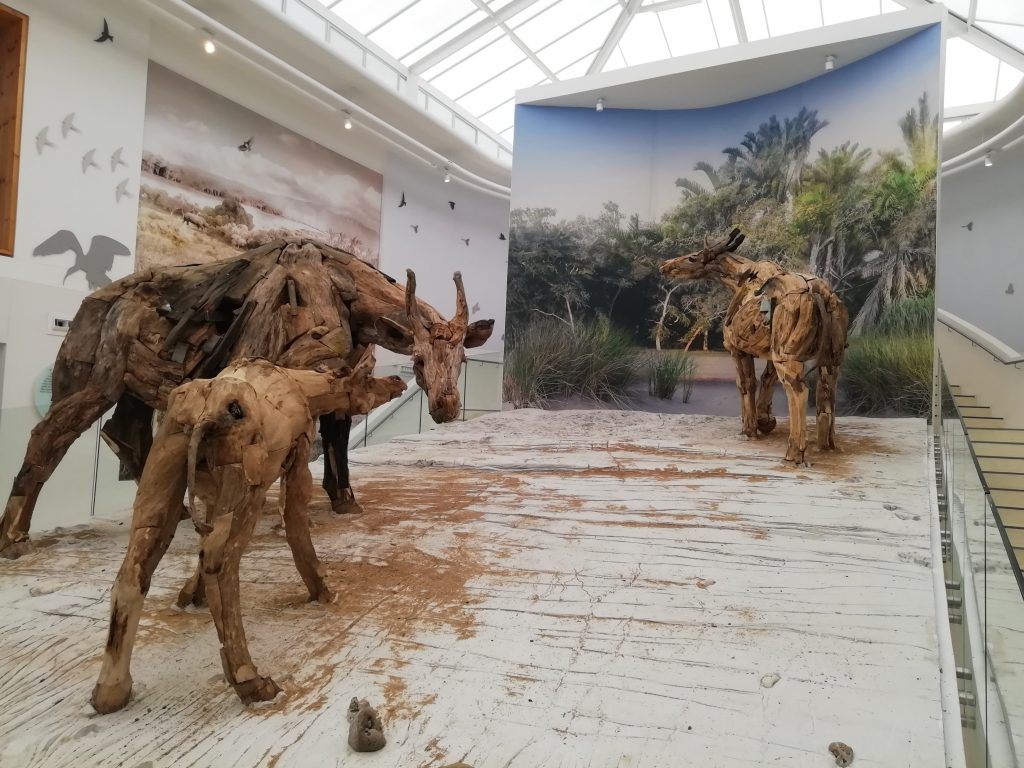 Figure 1. Artistic reconstructions of the Sivathere on display at the West Coast Fossil Park. Created by a local artist out of driftwood. Brigette Cohen 2019.
Figure 1. Artistic reconstructions of the Sivathere on display at the West Coast Fossil Park. Created by a local artist out of driftwood. Brigette Cohen 2019.Extraordinary Mammals
Langebaanweg has produced some truly exceptional mammal remains. I want, I have written, so many versions of this article, trying to explore them in detail, but there is just too much to say, so let’s stick with what it all means and what exceptional finds have raised profound questions (many still lacking answers).
The first thing to note is that many animal groups or families are represented at the site by multiple species, and it is unclear in many cases how they were able to cohabitate. At the same time, you will quickly realise when investigating the fauna of Langebaanweg how little in-depth analysis much of this material has been subjected to. Examples of this among the herbivores include three species of Proboscideans (elephants) including the first mammoth in Africa, a relative to the African elephant and a four-tusked gomphothere. Readers might remember that the mammoth was the very first fossil recovered from the site. Similarly, there are three species of giraffid including the sivathere. This okapi-like animal, standing over 2 m at the shoulder, occurred in extraordinary abundance, and remains of over 500 individuals (not fossils, but animals) have been recovered. There is an astonishing assemblage of micromammals (rats and mice), including evidence for eusociality in mole-rats. One of my favourite fossils is the giant pig Nyanzachoerus, because side-by-side, its skull is larger than the bear. There are remains of aardvark and pangolin – usually extremely rare in fossil sites. There is also hippo – indicating substantial standing water, but no crocodiles. Similarly, there is a near lack of primates, despite extensive support for forested environments. There is no good explanation for these absences so far. In short the herbivores vary from grassland to closed environments and quite a lot inbetween.
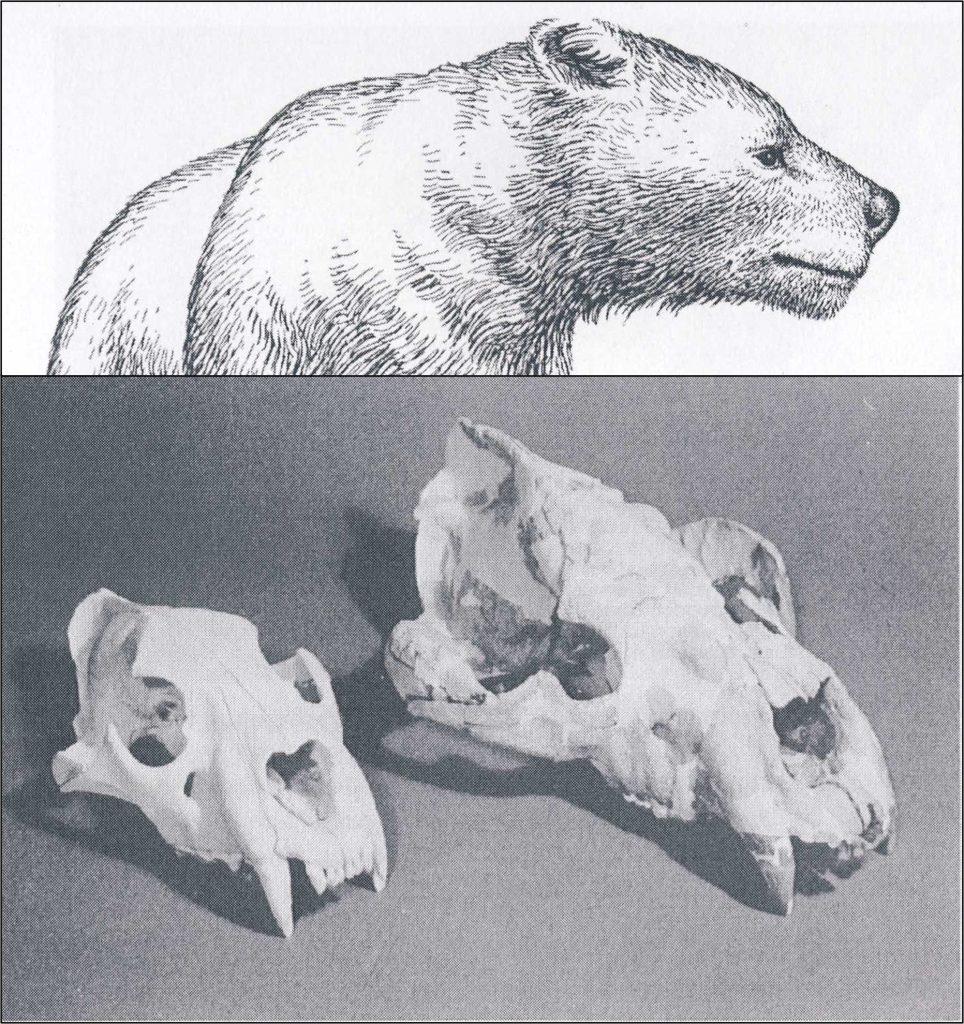 Figure 2. The African Bear, Agriotherium africanum. Above is a artistic reconstruction of the bear by Cedric Hunter, this design is no longer considered accurate. Below shows the bear skull on the right compared to a modern lion skull on the left. Image adapted from Hendey (1981).
Figure 2. The African Bear, Agriotherium africanum. Above is a artistic reconstruction of the bear by Cedric Hunter, this design is no longer considered accurate. Below shows the bear skull on the right compared to a modern lion skull on the left. Image adapted from Hendey (1981).The carnivore guild makes up as much as a third of the mammal species, which implies a comfortable abundance of prey animals. Possibly the most famous carnivore was the discovery of the first bear fossil in Africa, Agriotherium africanum. It is a large species, one of the best studied, and is today interpreted as a cursorial scavenger. There are 4-5 hyena species. This group at least shows evidence of niche differentiation with large and small species varying from durophagy (dental modifications for bone crushing – think spotted hyena) to hypercarnivory (exclusive meat eating – like big cats). I say 4-5 because there is an entirely undescribed species within the collection. Further, the hyper carnivorous hyenas didn’t manage to preclude the felines (another confused and understudied group). There are sabre-tooth cats, false sabre-tooth cats and more modern cats. The cats vary widely in size but there is a noticeable lack of small species. Of canids, there are only two; the family is basically unstudied, and it is not known why there are so few of them. Even the smaller carnivores make a better showing. The site has produced civet and genet and at least two (un-named and unstudied) mongoose species. There are otters, honey badger and the first occurrence of the wolverine in Africa, but there are no small mustelids (like weasels).
There are marine mammals in the form of whales and seals but no dolphins. The marine mammals tend to be disassociated and scattered and are often (like in the bonebed) mixed with terrestrial fauna, with signs of exposure on land. There are baleen and toothed whales. The seals are very common, even if attempts to identify and describe them are hamstrung by the lack of associated material. There is good evidence for a seal breeding colony in the vicinity.
There remain whole mammal families that are unstudied (bats, hyraxes, hares, golden moles) and as we saw above even within the ‘sexy’ groups there are species requiring reappraisal. There remains a host of work to be done just on the mammals.
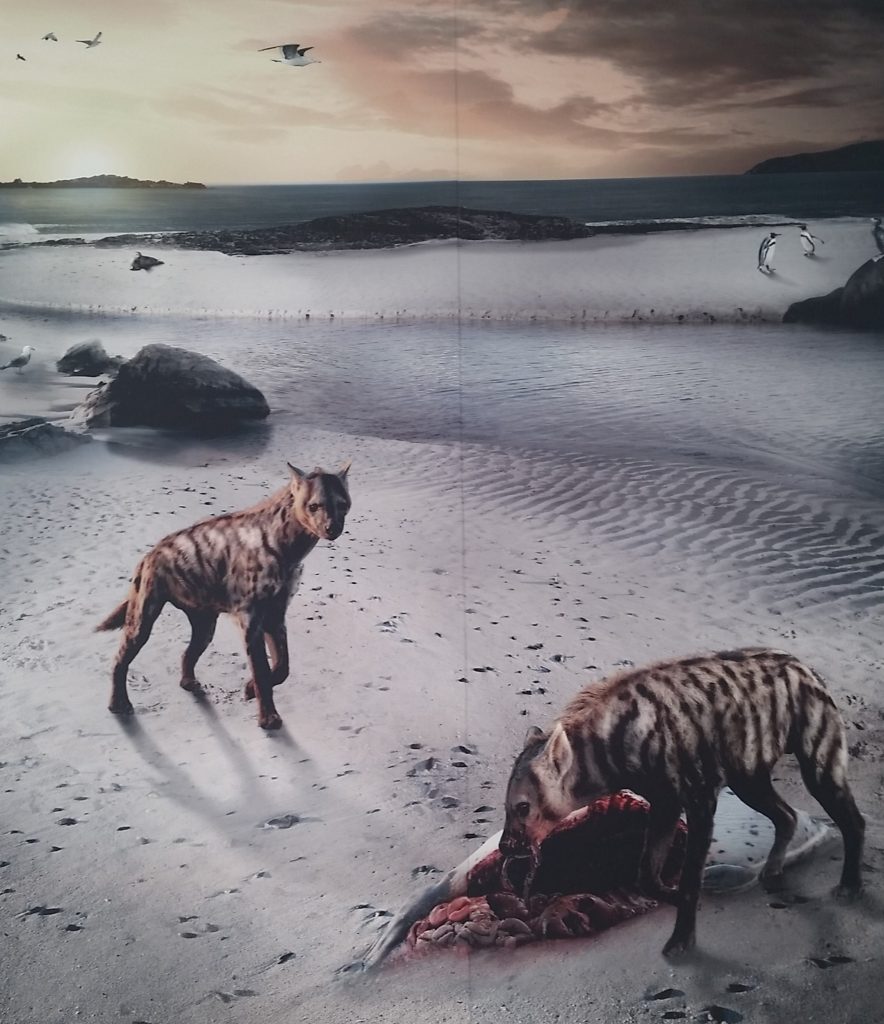 Figure 3. Artistic reconstruction of Langebaanweg coastal scene showing hyenas in foreground, penguins in the background and marine birds in the upper part. Part of a mural at the West Coast Fossil Park. Created by Adam Hartstone-Rose, 2019.
Figure 3. Artistic reconstruction of Langebaanweg coastal scene showing hyenas in foreground, penguins in the background and marine birds in the upper part. Part of a mural at the West Coast Fossil Park. Created by Adam Hartstone-Rose, 2019.Richness of Birds
Langebaanweg has been described as the best pre-Pleistocene bird site in the world, with over 90 species identified. This assemblage is, however, characterised by large gaps – whole unstudied families. Many of the bird species from the site are also isolated in time with huge temporal gaps between them and the next known members of their lineages, emphasising how exceptional the fossil preservation at the site is.
There are numerous marine birds, in fact a similar diversity has only been otherwise observed on certain subantarctic islands. Only the penguins (4 species) have been studied in detail. Further, the marine birds of Langebaanweg show no relationship to their relatives occurring in the region today, suggestions there has been a near complete turnover in the region, possibly even multiple independent colonisations. Mapping of sea-level changes, together with the presence of juveniles and neonates indicates that there were breeding colonies in the area, probably on offshore islands; which supports evidence from marine mammals.
The water birds are indicative of a perennial freshwater source with slow moving and marshy areas and dense vegetation. The most commonly occurring families of this group, ducks and gulls, are unstudied, although there may be as many as 15 gull species at the site. There is a single swan specimen (a first occurrence of the genus in sub-Saharan Africa), but there is some debate as to whether this might have been a vagrant occurrence. Further, there is one of the earliest occurrences of an ibis in Africa and at least two kingfishers. But there are notable exceptions like herons, flamingos and spoonbills.
There are numerous woodland birds, many of whom require tall trees for nesting. There are some of the oldest parrots and lovebirds in Africa, and the first appearance of a nightjar. There are hundreds of bones from songbirds (passerines), from at least 9 species, none of them studied. This includes the oldest African example of swallows.
The ostrich was the first bird material identified from Langebaanweg, but has never been studied in any detail. There are numerous grass-land, open-habitat and even arid environment species, of which the sandgrouse represents the oldest crown group appearance.
The predaceous birds are also common, even if they are not useful palaeooecological indicators. There is an extraordinary four owl species, and over 100 vulture bones. This is the oldest crown-group appearance of vultures.
Thus, the birds of Langebaanweg paint a picture of a mosiac environment with forest, grassland and freshwater environments, as well as marine colonies nearby. But, some caution must be placed in considering the environmental signal of birds at Langebaanweg as the potential concentrating and depositional mechanisms are not well understood.
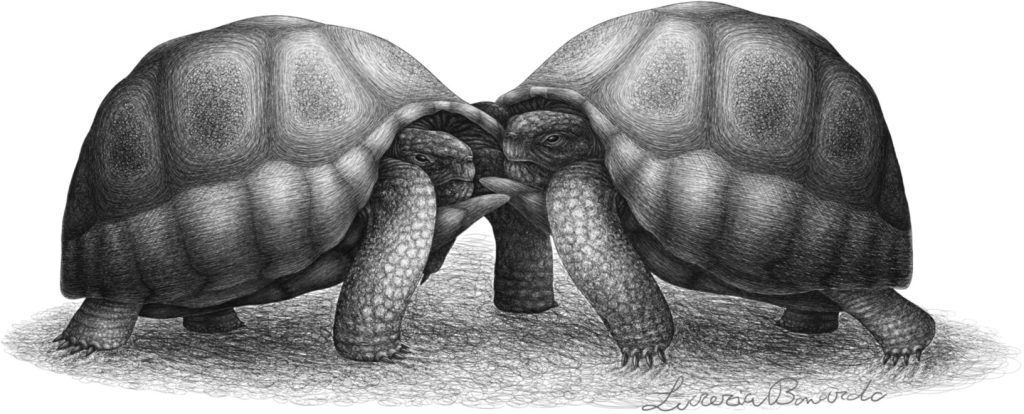 Figure 4. Artistic Reconstruction of the newly described tortoise, Chersina langebaanwegi, showing two males fighting (note the anterior projections on the shell used to flip the opponent onto his back). Created by L. Bonardo. From Delfino et al. 2025.
Figure 4. Artistic Reconstruction of the newly described tortoise, Chersina langebaanwegi, showing two males fighting (note the anterior projections on the shell used to flip the opponent onto his back). Created by L. Bonardo. From Delfino et al. 2025.The ‘unsexy’ stuff
There are many ‘unsexy’ animal groups at the site – mostly unstudied – like fish, sharks, invertebrates and numerous reptiles of which only the tortoises have received any attention. The palaeoecologial implications of many of these groups has been overlooked. But I will give a quick overview of the few that have received attention.
Tortoise remains are arguably the most common bone material recovered at Langebaanweg and the underlying mechanism for their abundance is not well understood, although sampling bias is certainly a part of it. Recently, new analysis of the group has described a new species Chersina langebaanwegi, and identified the presence of as many as four other species. So far, no evidence of marine turtles has been documented, but freshwater terrapins are in evidence – the lack of the former can not be explained at this time. Other reptiles include chameleon (one described species), gecko, lizards, and snakes.
The other group that has received extensive analysis is frogs. Langebaanweg has produced an extraordinarily rich assemblage with over 19 species. For comparison there are only four in the region today. They show a diversity of habitats and have been used in palaeoecological studies to mark, for example, rainfall extent and seasonality.
One last comment is to note that the site does not preserve any plant macrofossils, but pollen and phytoliths (plant microfossils) have been used for environmental reconstructions.
Conclusion
What I hope is clear from this discussion of Langebaanweg is the scale of this site and the palaeontological quality of its fossil material. The broad range of environments it samples and the many research opportunities it offers. It provides an unparalleled glimpse into a period in time that is both poorly represented in the geological record of Africa, while also being of extraordinary importance. It is a site with a long and extraordinary history and one that continues to offer researchers unrivalled opportunities to expand our understanding of evolution.
And let’s be honest here, it is a source of cool fossils.
The bonebed dig site and a selection of the fossils discussed above can be visited at the West Coast Fossil Park, Western Cape, South Africa. https://fossilpark.org.za/
Selected References
Cohen, B.F. (2017). Sedimentaology and Taphonomy of Cenozoic vertebrates from Langebaanweg, Cape west coast, South Africa; with palaeoecological interpretations. Unpublished Doctoral Dissertation, University of Cape Town, South Africa.
Delfino, M., Cohen, B.F., Govender, R., Haarhoff, P., Macaluso, L., Marino, L., Matthews, T., Wencker, L.C.M., and Pavia, M. (2024). Towards the origin of South African tortoises: a new Chersina species from the Early Pliocene fossil site of Langebaanweg. Zoological Journal of the Linnean Society, 202 (3), zlae146. https://doi.org/10.1093/zoolinnean/zlae146
Groenewald, P.A., Sealy, J., Stynder, D., Smith, K.M. (2020). Dietary resource partitioning among three coeval proboscidean taxa (Anancus capensis, Mammuthus subplanifrons, Loxodonta cookei) from the South African Early Pliocene locality of Langebaanweg E Quarry. Palaeogeography, Palaeoclimatology, Palaeoecology, 543, 109606.
Hendey, Q.B. (1981). Palaeoecology of the late Tertiary fossil occurrences in E’ Quarry, Langebaanweg, South Africa, and a reinterpretation of their geological context. Annals of the South African Museum, 84(1), 1–104.
Manegold, A., Louchart, A., Carrier, J., Elzanowski, A. (2013). The Early Pliocene avifauna of Langebaanweg (South Africa): a review and update. In Paleornithological Research 2013–Proceedings of the 8th International Meeting of the Society of Avian Paleontology and Evolution. 135–152.
Matthews, T., Denys, C. & Parkington, J.E. (2007). Community evolution of Neogene micromammals from Langebaanweg “E” Quarry and other west coast fossil sites, south-western Cape, South Africa. Palaeogeography, Palaeoclimatology, Palaeoecology, 245(3–4), 332–352.
Matthews, T., van Dijk, E., Roberts, D.L., Smith, R.M.H. (2015). An early Pliocene (5.1 Ma) fossil frog community from Langebaanweg, south-western Cape, South Africa. African Journal of Herpetology, 64(1), 39–53.
Rich, P. V. (1980). Preliminary report on the fossil Avian remains from Late Tertiary sediments at Langebaanweg, South Africa. South African Journal of Science, 76, 166–170.
Roberts, D.L., Matthews, T., Herries, A.I.R., Boulter, C., Scott, L., Dondo, C., Mtembi, P., Browning, C. (2011). Regional and global context of the Late Cenozoic Langebaanweg (LBW) palaeontological site: West Coast of South Africa. Earth-Science Reviews, 106 (3–4), 191–214.
Roberts, D.L., Neumann, F.H., Cawthra, H.C., Carr, A.S., Durugbo, E.U., Humphries, M.S., Cowling, R.M., Bamford, M.K. (2017). Palaeoenvironments during a Terminal Oligocene or Early Miocene transgression in a fluvial system at the southwestern tip of Africa. Global and Planetary Change, 150, 1-23.
Werdelin, L. (2006). The position of Langebaanweg in the evolution of carnivora in Africa. African Natural History, 2, 201.
Brigette Cohen was formerly a palaeontologist and museum scientist until she decided that academia didn’t suit her. Now she works as a science writer. Translating academic mumbo-jumbo into fascinating stories of past life on earth. South African born and raised, she is particularly keen on seeing the incredible palaeontology of Africa being shared. You can find more of her work here.
Tags: Bird, Lagerstatte, langebaanweg, Mammal, Miocene, Penguin, Pliocene, South Africa, Tortoise


 3 days ago
22
3 days ago
22
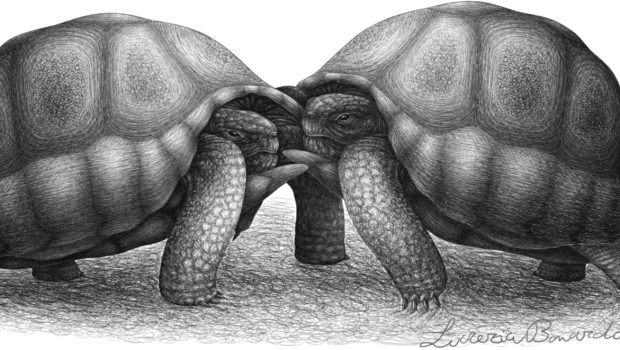
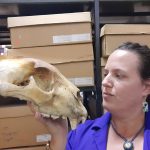





















 English (US) ·
English (US) ·  French (CA) ·
French (CA) ·